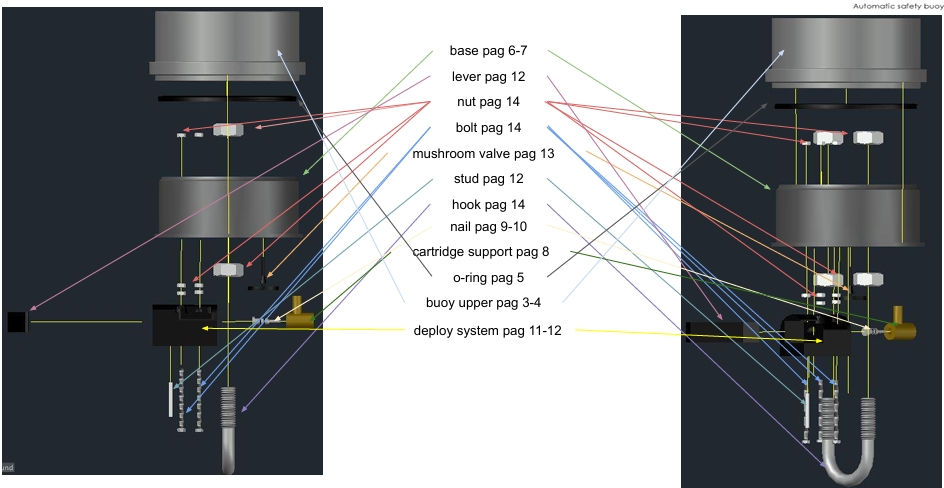
"Better to be on the boat wishing you were diving, than underwater wishing you were on the boat."
Augusto Pavan
AUTOMATIC SAFETY BUOY
A compact, ultra-fast deployment buoy system for emergency use underwater
Overview
During recreational dives, especially with beginner divers (OWD), I noticed how long and complicated it can be to deploy a surface marker buoy (SMB) in an emergency.
This inspired me to design a fully automatic system: just press one button, and the rest happens by itself — no manual inflation, no fumbling with reels, no training required.

Design Philosophy
From the beginning, my goal was simplicity, reliability, and accessibility:
-
One-button activation – usable even with thick gloves or in zero visibility.
-
Ultra-fast deployment – fully inflated and ascending in under 2 seconds.
-
No maintenance – uses disposable CO₂ cartridges, no refills or servicing.
-
Compact & lightweight – fits in a BCD pocket, weighs <200 g.
-
Affordable – total build cost under €20, versus ~$200 for commercial devices.
-
Open-source design – anyone can build or modify it.
This device is not meant to replace a standard SMB during normal dives — it’s a backup system for emergencies, when speed and ease of use are crucial.
This project was originally discussed with a French dive gear company, but after a week of collaborative refinement it was not pursued commercially.
I’ve decided to share the entire project freely, open-source, for anyone to build and improve.
HOW IT WORKS
A lever triggers a small steel pin that punctures the CO₂ cartridge, releasing gas that rapidly inflates the buoy.




FIRST PROTOTYPE






Here the complete project and presentation about first prototype


Safety and Reliability
-
The system has no moving parts during storage, reducing risk of accidental activation.
-
It is mechanically triggered, not electronic — works even with dead batteries or after years in storage.
-
It is not intended as a primary SMB: always carry a standard buoy for planned ascents.
-
This design is experimental and for personal use: test thoroughly in controlled conditions before real dives.
What you see here was the very first prototype.
Through testing, real-world use, and countless small improvements, the design evolved into the current Rev. 12 —
now reduced to its essence: a single 3D-printed body and a basic steel nail as the firing pin.

Components and Materials
-
ComponentDescriptionNotes
-
Buoy tubePolyurethane inflatable tubeFrom Decathlon (€4.99)
-
ValveMushroom-style one-way valveFrom Quechua camping mats (€2.99)
-
CO₂ cartridge16 g disposableStandard bike tire cartridges
-
Firing pinSteel nailPicture-frame nail works
-
Spring1 cm compressionAny hardware store
-
Cartridge supportAlloy 6071 or brass (⅛” 24 thread)Custom 3D part
-
Body3D printed (PETG-CF or resin)Printable on consumer printers
-
Cord (optional)10 mTo keep connection with diver
Total cost of all parts: < €20

LAST VERSION





FULL DRAW
BODY .STL
PLUG .STL
TRIGGER .STL
REEL .STL
Recreational diving safety often overlooks the human factor under stress.
Even experienced divers can struggle with fine-motor tasks when panicked or disoriented.
The Automatic Safety Buoy solves this by reducing the task to a single gross-motor action: push a button.
This could save precious seconds in a real emergency — and possibly save lives.
It also demonstrates how innovation can come from individual divers, not only from large manufacturers.
By sharing this design freely, I hope to inspire others to experiment, innovate, and contribute to safer diving practices.
